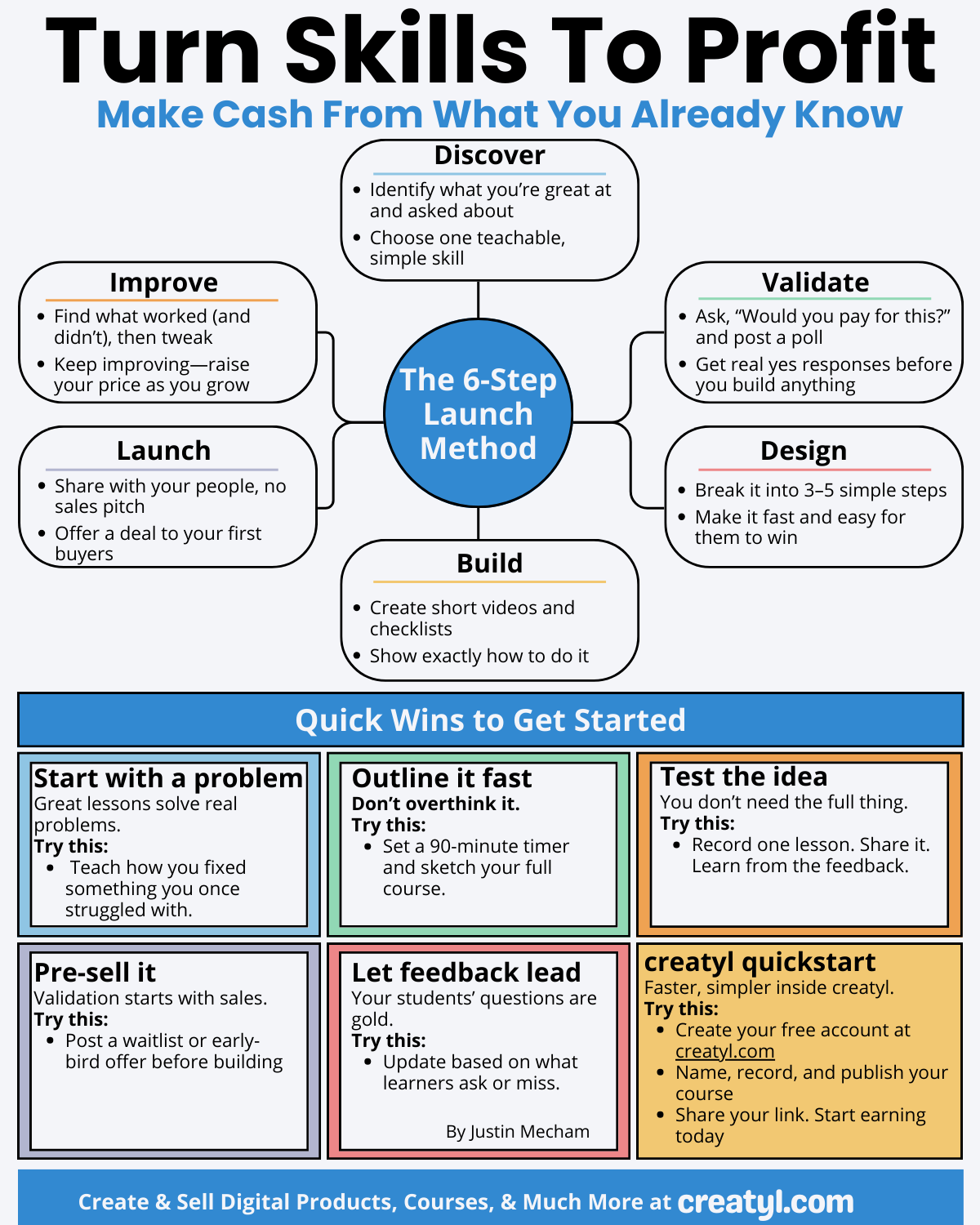Click Here to Download The PDF
Most people don’t give themselves enough credit.
They scroll past success stories thinking, “That’s not me,” or, “I don’t have anything worth sharing.”
But what if that’s the exact mindset holding you back from something real?
Here’s the truth: The things you’ve figured out—the things that seem small, obvious, or not impressive enough—are probably the very things someone else is searching for right now.
You don’t need a brand-new degree.
You don’t need a massive audience.
You don’t need to be a guru, expert, or polished creator.
What you do need is a way to package what you already know and share it in a way that helps others.
And when you do that well, you don’t just help them—you help yourself build income, confidence, and momentum.
This article walks you through how to do exactly that.
We’ll dive deep into the full process, real workplace stories, smart tools, and the most valuable mindset shifts you can make along the way.
Let’s go.
Why Most People Stay Stuck
We’re taught to chase permission.
Wait for approval.
Wait until someone else says, “You’re good enough now.”
That programming runs deep.
So even when we have knowledge, skills, or experiences that could genuinely help people, we talk ourselves out of doing anything with them.
We think:
- It’s not valuable enough.
- Someone else already said it.
- I’m not an expert.
But here’s what most people miss: People don’t want perfect.
They want real. They want shortcuts. They want help that works.
And if you’ve figured something out that others are still stuck on—whether it’s writing clean emails, setting up automations, managing a chaotic team, or organizing a busy life—you already have something worth offering.
You just need a way to turn it into something useful and sharable.
The 6-Step Launch Method That Actually Works
Here's a framework that makes this whole process simple and doable.
It’s not about scaling fast.
It’s about starting smart.
Here’s the method:
- Discover – Pick one skill you're naturally good at. Something people already ask you about. Keep it simple.
- Validate – Ask real people, “Would you pay for this?” Don’t assume. Confirm.
- Design – Break it into 3–5 steps. People want wins, not overwhelm.
- Build – Make it real. Record a quick video. Write a checklist. Nothing fancy.
- Launch – Share it. No pitch needed. Just a real story and a simple offer.
- Improve – Tweak it. Watch what works. Raise your price over time.
It’s straightforward—but only if you stop overthinking and start doing.
Real Workplace Stories: These Steps in Real Life
Sometimes the best way to understand a system is to see it in action.
So here’s what this process looks like in the real world—based on true scenarios you’ve probably seen in your own work or life.
1. Discover: A Checklist That Changed Everything
An account manager on a mid-size team noticed something—every time they onboarded a new client, it turned into a disorganized scramble.
Everyone was duplicating work.
Emails were missed.
Projects fell behind before they even started.
But she had a system.
Quietly, over months, she had created her own onboarding checklist to help things run smoother.
It wasn’t anything revolutionary.
Just something that helped her stay on top of things.
Until one day, her manager asked her to share it in a team meeting.
That one doc?
It became the backbone of the company’s new onboarding process.
It saved them over 25 hours a month and reduced churn in the first 90 days by 30%.
And here’s the thing: She never thought it was a skill worth sharing.
But it was.
The takeaway:
What’s obvious to you might be priceless to someone else.
2. Validate: The Course That Almost Failed
A team lead wanted to create a mini training on productivity.
They went all in—designed slides, recorded modules, set up a landing page.
When they launched it? Two sales.
They were frustrated but curious, so they asked the people who didn’t buy: “What’s your biggest productivity problem?”
The answer came back loud and clear: “I can’t say no. My schedule fills up before I have a chance to focus.”
So they pivoted.
They rewrote the whole thing as: “How to Say No Without Guilt and Still Stay Productive.”
One video. One worksheet.
They relaunched with a simple message and sold 20 copies in three days.
The takeaway:
Let your audience tell you what they need. Don’t guess. Ask.
3. Design: When a 2-Hour Training Was Replaced With 10 Minutes
An HR manager was tired of no one finishing the company’s required feedback training.
It was boring. It was long. It didn’t help anyone.
So she stripped the whole thing down to what actually mattered:
- How to prepare
- What to say
- How to deliver it clearly
She recorded a 10-minute video.
She included a printable cheat sheet with example phrases.
She sent it out without any hype.
Over 80% of managers used it within the first week.
Feedback quality improved. No one asked for the old course again.
The takeaway: Short. Clear. Actionable. That’s what people want.
4. Build: From Repeating Yourself to Earning While You Sleep
A freelance designer was constantly asked the same thing: “How do you write such good client proposals?”
Instead of answering one more DM, she hit record on Loom and walked through her proposal template.
She uploaded the video and the template to a folder and charged $9 for access.
In one day, she made $100 and freed up hours of her time.
The takeaway: If you keep repeating yourself, it’s time to record it once and let it work for you.
5. Launch: A Simple Share That Led to a Company-Wide Tool
A tech lead built a resource for onboarding junior developers—just something to help new hires get up to speed.
When they mentioned it to a coworker, they were told, “You should share this with the whole team.”
They didn’t want to self-promote, so they posted this in Slack:
“Put together a doc to help our new devs get comfortable faster. Saved our team about a week of ramp-up. Let me know if you want it.”
Within hours, five teams asked for it.
A month later, it was added to the official onboarding process.
The takeaway: You don’t need a sales page. Just share what helped you.
6. Improve: How Two Buyers Helped Build a Hit
A project manager launched a training on how to run effective weekly meetings.
Two people signed up.
They didn’t quit.
They asked those two what they liked.
Turns out, no one wanted better meetings.
They wanted shorter ones.
So they renamed the course: “How to End a 60-Minute Meeting in 25.”
They added one simple lesson.
They raised the price.
Sales exploded.
The takeaway: The first version is just a draft. Let people shape the second.
Quick Wins That Actually Work
You don’t need a full-blown business plan to start.
You need motion. These quick wins help you build momentum:
- Teach something you solved. No theory. Just real, helpful steps.
- Outline your course in 90 minutes. Set a timer. Write messy. Edit later.
- Record one short video. Screen record what you’re already doing well.
Stop waiting to launch. Start making something useful.
Tools That Make It Easy to Start
Some tools can remove friction so you can move faster:
- Coursebox AI – Turn raw ideas into real courses fast
- Synthesia – Create video content without being on camera
- Arist – Build bite-sized training that fits into real workflows
- creatyl.com – Publish and share your course in one place, without the hassle
Use the tools. Save your energy for the parts that matter.
Go Deeper with These Proven Resources
If you want to rewire how you see your skills and creativity, these are worth your time:
- Book: Steal Like an Artist by Austin Kleon – Creativity is remixing what you already know. This will change how you view your knowledge.
- TED Talk: The AI-powered tools supercharging your imagination by Bilawal Sidhu – You don’t need to be technical to build something powerful.
- Podcast: Skills to Income by Mohd Altamash – Actionable insights from people turning what they know into what they sell.
Start Before You Feel Ready
You don’t have to feel ready to be useful.
There’s a quiet kind of waiting most people live in.
Waiting until they’re more confident.
Waiting until they have more time.
Waiting until someone else tells them they’re allowed to begin.
But in that waiting, skills go unused. Ideas fade.
Opportunities pass.
The truth is, no one will tap you on the shoulder and say, “Now it’s time.”
You are the one who decides that.
If you’ve figured out something others are struggling with, then you already have value.
And when you stop trying to prove yourself and start sharing what works—you stop feeling stuck.
You begin to move forward.
Not because everything’s perfect.
But because you finally stopped waiting to believe what was already true:
What you know is worth something.
And it’s worth something now.
Download the Infographic
Want to keep this method close as you build?
Download the full “Turn Skills to Profit” infographic as a printable PDF.
Save it, keep it nearby, or share it with someone who needs a starting point.




